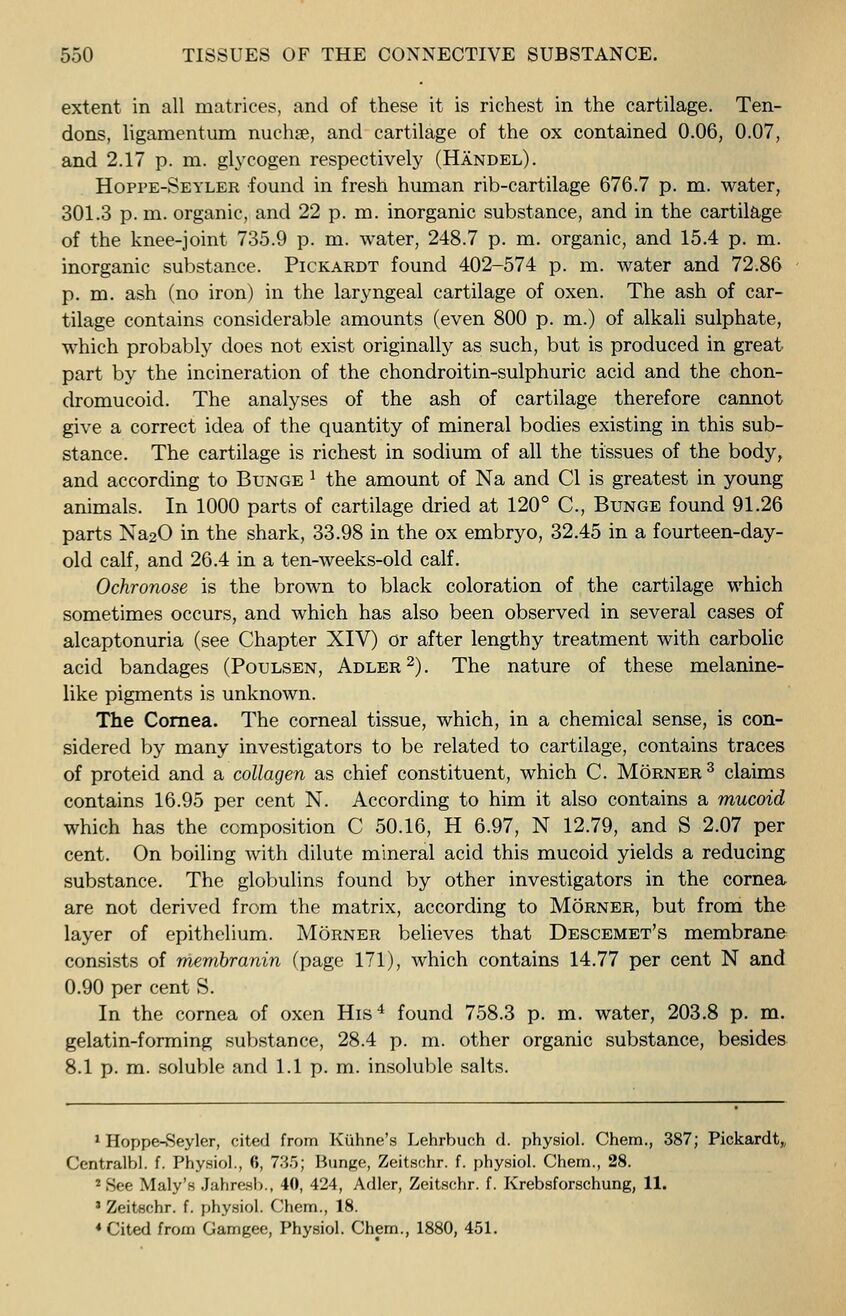
Full resolution (JPEG) - On this page / på denna sida - IX. Tissues of the Connective Substance - II. Cartilage

<< prev. page << föreg. sida << >> nästa sida >> next page >>
Below is the raw OCR text
from the above scanned image.
Do you see an error? Proofread the page now!
Här nedan syns maskintolkade texten från faksimilbilden ovan.
Ser du något fel? Korrekturläs sidan nu!
This page has never been proofread. / Denna sida har aldrig korrekturlästs.
550 TISSUES OF THE CONNECTIVE SUBSTANCE.
extent in all matrices, and of these it is richest in the cartilage. Ten-
dons, ligamentum nucha?, and cartilage of the ox contained 0.06, 0.07,
and 2.17 p. m. glycogen respectively (Handel).
Hoppe-Seyler found in fresh human rib-cartilage 676.7 p. m. water,
301.3 p. m. organic, and 22 p. m. inorganic substance, and in the cartilage
of the knee-joint 735.9 p. m. water, 248.7 p. m. organic, and 15.4 p. m.
inorganic substance. Pickardt found 402-574 p. m. water and 72.86
p. m. ash (no iron) in the laryngeal cartilage of oxen. The ash of car-
tilage contains considerable amounts (even 800 p. m.) of alkali sulphate,
which probably does not exist originally as such, but is produced in great
part by the incineration of the chondroitin-sulphuric acid and the chon-
dromucoid. The analyses of the ash of cartilage therefore cannot
give a correct idea of the quantity of mineral bodies existing in this sub-
stance. The cartilage is richest in sodium of all the tissues of the body,
and according to Bunge 1
the amount of Na and CI is greatest in young
animals. In 1000 parts of cartilage dried at 120° C, Bunge found 91.26
parts Na^O in the shark, 33.98 in the ox embryo, 32.45 in a fourteen-day-
old calf, and 26.4 in a ten-weeks-old calf.
Ochronose is the brown to black coloration of the cartilage which
sometimes occurs, and which has also been observed in several cases of
alcaptonuria (see Chapter XIV) or after lengthy treatment with carbolic
acid bandages (Poulsen, Adler 2
). The nature of these melanine-
like pigments is unknown.
The Cornea. The corneal tissue, which, in a chemical sense, is con-
sidered by many investigators to be related to cartilage, contains traces
of proteid and a collagen as chief constituent, which C. Morner 3
claims
contains 16.95 per cent N. According to him it also contains a mucoid
which has the composition C 50.16, H 6.97, N 12.79, and S 2.07 per
cent. On boiling with dilute mineral acid this mucoid yields a reducing
substance. The globulins found by other investigators in the cornea
are not derived from the matrix, according to Morner, but from the
layer of epithelium. Morner believes that Descemet’s membrane
consists of membranin (page 171), which contains 14.77 per cent N and
0.90 per cent S.
In the cornea of oxen His 4
found 758.3 p. m. water, 203.8 p. m.
gelatin-forming substance, 28.4 p. m. other organic substance, besides
8.1 p. m. soluble and 1.1 p. m. insoluble salts.
1 Hoppe-Seyler, cited from Kiihne’s Lehrbuch d. physiol. Chem., 387; Pickardt,,
Centralbl. f. Physiol., 6, 735; Bunge, Zeitschr. f. physiol. Chem., 28.
2
See Maly’s Jahresb., 40, 424, Adler, Zeitschr. f. Krebsforschung, 11.
’ Zeitschr. f. physiol. Chem., 18.
4
Cited from Camgee, Physiol. Chem., 1880, 451.
<< prev. page << föreg. sida << >> nästa sida >> next page >>